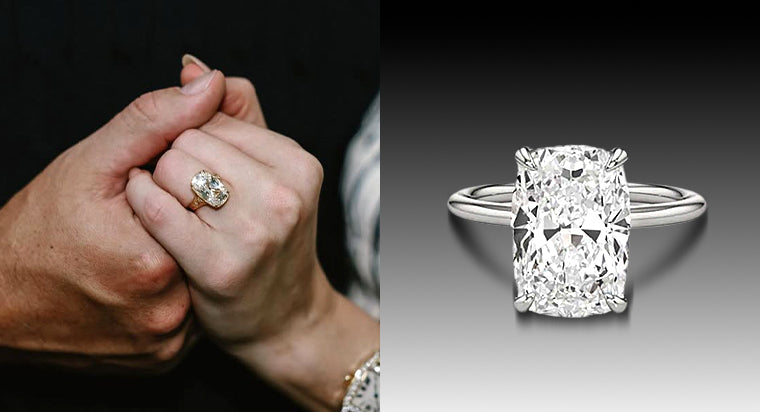Lab Diamond Engagement Rings - The Importance of Certification and Grading

Lab diamond engagement rings, continue to gain popularity, but most people don't know a lot about lab grown diamonds. We've created a comprehensive guide about the grading and certification of lab diamonds. We'll cover all you need to know about lab diamonds so you can feel confident finding the right stone for you.
TABLE OF CONTENTS
Introduction to Lab Diamond Engagement Rings
Lab grown diamonds, look exactly like natural diamonds, in terms of their physical, optical, and chemical characteristics. The only difference between the two is that natural diamonds have traces of nitrogen, but lab diamonds don't. And the only way to spot the difference is with a microscope. More modern couples have sought lab diamonds in the recent past because they're ethically sourced and environmentally friendly.
Certification and Grading Overview
Now that you know more about lab diamonds, let's discuss how they're graded and certified. Lab diamonds and mined diamonds both use the 4Cs (carat weight, cut, color, and clarity) , to grade the quality. These factors influence the diamond's quality and impact its price.
Both lab and minded diamonds get certified by gemological laboratories. They evaluate each diamond and provide a detailed report on its quality. It'll detail each aspect of the diamonds' quality (carat, cut, color, and clarity). Getting a certified diamond verifies the authenticity of your purchased diamond and provides peace of mind.
Certification Authorities
The three main certification authorities are the Gemological Institute of America (GIA), the International Gemological Institute (IGI), and the American Gem Society (AGS). The GIA and IGI use the 4Cs to grade each diamond. AGS uses light performance, proportions, and craftsmanship to grade diamonds. It provides a diamond grading report called the AGS Platinum Diamond Quality Document. Both IGI and GIA issue a diamond grading report that provides a detailed analysis of the diamond's quality.
Grading Criteria
We briefly mentioned what the 4Cs are, but it's helpful to know exactly what they are so you can choose the perfect lab diamond for your engagement ring. Cut refers to the shape of the diamond and also how well the diamond is cut. The cut of the diamond impacts how it reflects light and sparkles. Color is the overall hue of the diamond, varying from colorless to a light yellow/brown. A colorless diamond has an icy appearance, while lower-quality diamonds are warmer. Clarity is the inclusions within each stone and even lab diamonds will have natural inclusions because they're part of the diamond-forming process. Carat weight refers to the weight and size of the diamond. These factors work together to create the overall diamond quality and affect its appearance.
Importance of Certification
Certification is helpful because it provides consumers with verification of the diamond they're buying. It's also nice to have all of the quality factors explained in a report. You'll see where each inclusion is on the stone. Reports also confirm that it's an authentic lab diamond, which is an ethically sourced stone.
Comparing Lab Diamonds to Natural Diamonds
There are some common myths when it comes to natural and lab diamonds. Some believe lab diamonds aren't "real" diamonds, which is incorrect. As noted earlier, lab diamonds are the same chemically, physically, and optically as natural diamonds. You can't distinguish between them with the naked eye – only with magnification by expert gemologists. Certification will confirm the type of diamond that you have. Keep in mind that grading standards are the same between natural and lab diamonds.
Ethical and Environmental Considerations
Most modern couples are appreciative of the environmental and ethical advantages of lab diamonds. Creating them has a smaller environmental impact than diamond mining. Lab diamonds are created in a controlled environment rather than in the earth's surface. Certification backs up the fact that the diamond you're buying is ethical and sustainable.
Consumer Guidance
Men and women have personal preferences when it comes to choosing diamonds for engagement rings. You'll need to balance the quality of the diamond you'd like with your budget. You have more choices with lab diamonds and can definitely find diamonds in your price range. Each diamond is unique, so carefully examine each stone you're considering. Ask if the diamonds are certified and review the grading reports as well. Reputable jewelers sell certified diamonds. Research any retailer you're thinking of, including the online reviews, company policies, and warranty info. With Clarity has only certified diamonds, so you can choose your favorite piece without worrying about its authenticity.
Future Trends
Technology is constantly changing, which also applies to the jewelry industry. Processes used to create lab diamonds have evolved over time and will keep improving. The demand continues to increase, so more lab diamonds are being produced. As a result, the production techniques get more refined as well. Diamond certification and grading standards will also continue to evolve in order to meet future changes in the diamond industry. Technology advances and consumer preferences will continue to change, so the diamond certification and grading might need to evolve as well.
As more lab diamonds enter the market, future grading and certification might include the details about the lab where the stone was created and the specific diamond's environmental impact. Imaging techniques may also improve so the grading process could provide more accurate and detailed assessments of a diamond's characteristics. Certification and grading are essential aspects of any diamond you choose.









